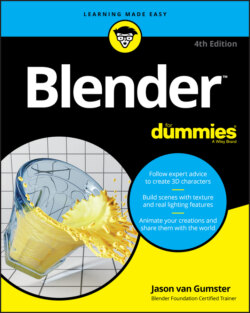Читать книгу Blender For Dummies - Jason van Gumster - Страница 49
Collaborating (with others and yourself) with annotations
Оглавление If you’re making anything big with 3D computer graphics like a movie or a video game, you’re most likely going to be collaborating with other people. 3D computer graphics in general, and animation specifically, is an extremely collaborative art form. Otherwise, it would take forever to get anything completed. If you’re working with other people, it’s often useful to be able to pass notes to each other within the context of your work so you can give helpful feedback or let the next person in the pipeline know why you did something. In fact, this can even be useful if you’re working solo. I leave notes to myself all the time in my .blend files as reminders so I don’t have to mentally keep track of every random design decision I made while working.
Blender’s annotation feature gives you the ability to leave these kinds of notes in your .blend files, right in the editor you’re working in. The controls for annotations are at the bottom of the View tab of the Sidebar. Expand the Annotations panel and you should see a button labeled New. Click that button and the panel will expand to look like what’s shown in Figure 2-11.
The list box can hold multiple layers of annotations. By default Blender pre-populates this list box with a single layer named Note. To the left of the layer is a color swatch that dictates the color of any annotations on that layer. Add and remove layers by using the plus and minus buttons to the right of the list box. Below the layer list box is a Thickness slider that controls the thickness of any annotations you make on that layer.
The easiest way to make a new annotation is to use the Annotate tool in the Toolbar. Activate this tool by clicking and you’re instantly able to start writing and drawing in your 3D Viewport on your active annotation layer. If you hold down your mouse button while clicking the Annotate tool in the Toolbar, you also get options to draw lines, polygons, and erase.
FIGURE 2-11: The Annotations panel in the View tab of the Sidebar is where you control how your annotations look in the 3D Viewport.
For faster access to annotating, you don’t have to use the Annotate tool. You can just hold down D while left-clicking and dragging your mouse cursor in the 3D Viewport. This action gives you quick access to Annotate’s draw tool and lets you add marks on whichever annotation layer you have active in the Sidebar.
Technically, you can even animate your annotations (for giving feedback on animated work). You just need to scrub forward on the Timeline and make a new annotation mark. Your annotations will update on playback as you change to those frames. You can adjust the timing of your annotations from the Grease Pencil context of the Dope Sheet.
You can actually make quite detailed and intricate animations using annotations alone. However, if you’re going to try and do full-blown 2D or 2.5D animation, I suggest you use Blender’s Grease Pencil objects instead. They’re more powerful and way better-suited for the job. See Chapter 15 for more on animating with Grease Pencil.
